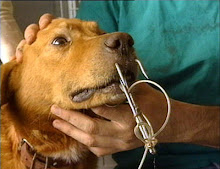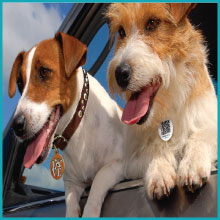Friday, August 26, 2011
American Humane Association And The ASPCA To Deploy During Hurricane Irene
American Humane Association Mobilizes to Help Animals in Path of Hurricane Irene
Charity Offers Tips to Help Keep Children and Pets Safe
Following storm tracking on their mobile command center within the 82-foot rescue truck that houses 12 specially trained staff and volunteers, American Humane Association is driving its famed Red Star™ Animal Emergency Services team into position to be ready to help animals that may need rescue or shelter from Hurricane Irene.
Red Star has a nearly century-long legacy of animal relief, beginning with a Federal request to help wounded horses on WWI European battlefronts, now a theme in Broadway's "War Horse." Today, Red Star first-responder teams provide on-the-ground rescue and support services to State and local agencies and shelters by official invitation. The largest truck in the Red Star convoy carries rescue boats, a hoist, food and medical supplies, snap-together kennels for extending or creating animal shelters, food bowls and other items to keep animals safe and cared for. These animals may range from family pets in need of temporary shelter if their families must evacuate their homes to animals rescued from dangerous conditions.
Just recently, Red Star teams have served animal needs in Joplin, MO after its tornado, and animals in the flooded cities of Memphis, TN, and in Minot, North Dakota.
Even as the Red Star 82-foot truck drives toward North Carolina from its Denver home base, American Humane Association President Dr. Robin R. Ganzert waits out the hurricane on her North Carolina farm. "It's very important that families, and especially children, know that we will help keep their animals safe and sound should there be a need to evacuate homes," she says. "Before, during, and after a storm, it's important to know what to do to keep children and pets safe."
To that end, American Humane Association has prepared these tips:
.Before the storm
•Tie down or anchor outside objects that might fly about and injure someone.
•Bring children and pets inside; bring outdoor animals inside with a carrier ready large enough to turn around and lie down comfortably.
•Review your evacuation plan and double-check emergency supplies, bowls, water, food.
•Have a carrier at the ready.
•If your family must evacuate, take your pets with you.
During the storm ... if you cannot evacuate
•Choose a safe room for riding out the storm—an interior room without windows – and take your entire family there, including your pets.
•Stay with pets. If crated, they depend on you for food and water.
•Keep your emergency kit in that room with you (food, water, litter, meds).
•Know your pet's hiding places. That's where they may run; keep them with you.
•Secure exits and cat doors so pets can't escape into the storm.
•Do not tranquilize your pets. They'll need their survival instincts should the storm require that.
After the storm
•Make sure the storm has fully passed before going outside and assessing damages before allowing children or animals out.
•Keep dogs on a leash and cats in a carrier, and children close at hand. Displaced objects and fallen trees can disorient pets and sharp debris could harm them.
•Give pets time to become re-oriented. Familiar scents and landmarks may be altered and cause a pet to become confused or lost.
•Keep kids and animals away from downed power lines and water that may be contaminated.
•Keep an eye on children's emotional reaction to the crisis. Talk to children – and just as important – listen to them. Reassure them frequently that you, local officials, and their communities are all working to keep them safe and return life back to normal. Watch for symptoms of stress, including clinginess, stomachaches, headaches, nightmares, trouble eating or sleeping, or changes in behavior. If you are concerned about the way your children are responding long after the crisis is over, consult your doctor, school counselor or local mental health professional.
•Uncertainty and change in the environment affect animals, too, presenting new stresses and dangers. Your pet's behavior may change after a crisis, becoming more aggressive or self-protective. Be sensitive to these changes and keep more room between them, other animals, children or strangers. Animals need comforting, too. Comfort your pet with kind words and lots of pats or hugs. If possible, provide a safe and quiet environment, even if it is not their home.
"Our hearts go out to the thousands of people and animals in the path of this developing disaster," says Dr. Ganzert. "This year has held some of the most devastating weather on record. To those in need we will bring a century of experience and all of our resources in animal rescue. Help is on the way."
For more news about the Red Star team's emergency work during these disasters, please go to www.americanhumane.org
Where the American Humane Association Red Star™ team will be:
•Friday to Sunday: Staging at 1025 Blue Ridge Blvd, Fairgrounds, Raleigh, NC
•Sunday: Moving to Bob Martin Eastern Agricultural Center, Williamston, NC
About American Humane Association
Since 1877 American Humane Association has spearheaded major advances in protecting children, pets and farm animals. Today we're also leading the way in understanding the human-animal bond and its role in creating a more compassionate world. American Humane Association's science-based research and services span a wide network of organizations, government policies, and professionals in child or animal welfare. You can help make a difference, too. Visit American Humane Association at www.americanhumane.org today.
SOURCE American Humane Association
NYC Animal Welfare Agencies Deploy Responders in Preparation for Hurricane Irene
Pet owners urged to develop emergency plan
New York City animal welfare agencies, at the request of the New York City Office of Emergency Management (OEM), are mobilizing resources within the OEM's Animal Planning Task Force to aid in the emergency rescue and sheltering of animals in anticipation of Hurricane Irene.
The ASPCA® (The American Society for the Prevention of Cruelty to Animals®), NYC Animal Care & Control (AC&C), the Mayor's Alliance for NYC's Animals, Bideawee, and NYC Veterinary Emergency Response Team (VERT) are urging pet owners to develop an emergency plan in advance to keep their families and pets safe. These agencies have also committed resources that include animal sheltering, veterinary support, search and rescue, supplies, staff, volunteers, and transport to provide aid in the days ahead.
"Disasters threaten the safety of people and animals alike, and it's often too late to create a plan for your pets when you're in the middle of a crisis," says Tim Rickey, senior director of the ASPCA's Field Investigations and Response team. "Why risk not being prepared for an emergency when all it takes is following some very simple steps?"
The Animal Planning Task Force offers the following tips on emergency preparedness:
•Always bring pets indoors at the first sign or warning of a storm or disaster.
•Make sure all pets wear collars and ID tags with up-to-date identification. Micro-chip your pet as a more permanent form of identification.
•Keep a pet emergency kit and supplies handy with items such as medical records, water, pet food and medications, and pet first aid supplies. Take this with you if you evacuate.
•Arrange a safe haven for your pets in the event of evacuation. Do not leave your pets behind.
•Choose a designated caregiver who can take care of your pet in the event you are unable.
For families who must evacuate, the City's evacuation centers, as well as its emergency shelters, will be pet friendly, and people are encouraged to evacuate with their pets. Low-lying areas of the city that are most at risk for flooding and other damage and are designated as "Zone A" low-lying areas in the Coastal Storm Plan include Coney Island and Manhattan Beach in Brooklyn, Far Rockaway and Broad Channel in Queens, South Beach, Midland Beach, and other low-lying areas on Staten Island, and Battery Park City in Manhattan. For details and updates, please visit the OEM's website at www.NYC.gov/oem, or call 311 to find an evacuation center.
New York City's Office of Emergency Management created the Animal Planning Task Force to develop plans for disasters — both natural and otherwise. The task force includes representatives from the ASPCA, the Mayor's Alliance for NYC's Animals, Animal Care and Control of NYC, NYC Veterinary Emergency Response Team, the NYC Department of Health and Mental Hygiene (DOHMH), NYC Department of Parks & Recreation, American Red Cross in Greater New York, Bideawee, Humane Society of the United States, Suffolk County Society for the Prevention of Cruelty to Animals, and Veterinary Medical Assistance Team One (VMAT-1).
For more information on disaster preparedness and safety tips from the ASPCA, please visit www.aspca.org/pet-care/disaster-preparedness/. For updates on the impact of Hurricane Irene on the animals in New York City, please visit www.aspca.org.
About the ASPCA®
Founded in 1866, the ASPCA® (The American Society for the Prevention of Cruelty to Animals®) is the first humane organization established in the Americas and serves as the nation's leading voice for animal welfare. One million supporters strong, the ASPCA's mission is to provide effective means for the prevention of cruelty to animals throughout the United States. As a 501(c)(3) not-for-profit corporation, the ASPCA is a national leader in the areas of anti-cruelty, community outreach and animal health services. The ASPCA, which is headquartered in New York City, offers a wide range of programs, including a mobile clinic outreach initiative, its own humane law enforcement team, and a groundbreaking veterinary forensics team and mobile animal CSI unit. For more information, please visit www.aspca.org. To become a fan of the ASPCA on Facebook, go to http://www.facebook.com/aspca. To follow the ASPCA on Twitter, go to http://www.twitter.com/aspca.
About Animal Care & Control
Animal Care & Control of New York City (AC&C) is the largest pet organization in the North East, with nearly 40,000 animals rescued each year. As a non-profit organization since 1995, AC&C has been responsible for New York City's municipal shelter system; rescuing, caring for and finding loving homes for homeless and abandoned animals in New York City. AC&C facilities operate in all five boroughs to service all NYC communities.
About the Mayor's Alliance for NYC's Animals®
The Mayor's Alliance for NYC's Animals, Inc., founded in 2002 and powered by Maddie's Fund®, The Pet Rescue Foundation, with support from the ASPCA, is a coalition of more than 150 animal rescue groups and shelters working with Animal Care & Control of New York City (AC&C) to end the killing of healthy and treatable cats and dogs at AC&C shelters. To achieve that goal, the Alliance, a 501(c)(3) not-for-profit corporation, helps its Alliance Participating Organizations (APOs) work to their highest potential to increase pet adoptions and spay/neuter rates, with the goal of transforming New York City into a no-kill community by 2015. www.AnimalAllianceNYC.org.
About New York City Veterinary Emergency Response Team
New York City Veterinary Emergency Response Team is a volunteer group of veterinarians and animal health professionals dedicated to the support of New York City's working and companion animals in times of disaster.
About Bideawee
Bideawee, which means "stay awhile," in Scottish, is one of the country's oldest and most respected animal welfare and pet adoption organizations. Founded in 1903 by Mrs. Flora Kibbe, Bideawee has been providing shelter, care and compassion to homeless animals in helping them to find their forever homes for over 100 years.
Bideawee is a not-for-profit 501(c) 3 humane animal organization and 100% of Bideawee's funding comes from private sources. For more information visit: www.bideawee.org.
SOURCE ASPCA
Subscribe to:
Post Comments (Atom)




No comments:
Post a Comment